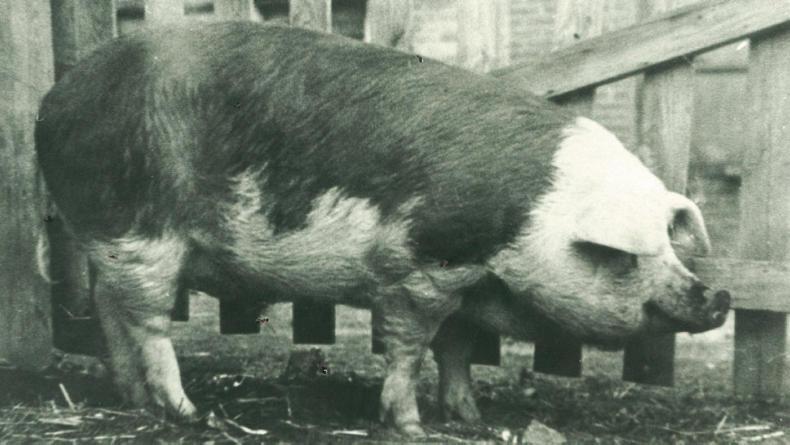Every war has heroes; some go unsung, while others become king. During World War II, from the midwestern state of Illinois came one such warrior. The only thing was; he wasn’t human. King Neptune was actually a Hereford swine, a breed characterised as mostly red, with a white face and ears and at least two white feet. Similar to that of the Hereford breed of cattle.
Spared from a fate on a barbecue spit, this patriotic porker became a home-front star raising $19m in war bonds (over $308m in 2019 adjusted for inflation).
In 1942 on Sherman Boner’s farm near West Frankfort, in southern Illinois, more than a thousand miles from the nearest ocean, Neptune was born. This runt of 12 piglets was blessed when young Patty Boner took a shine to him and began to raise him as a project for her local 4-H club (think American Macra). Patty Boner named the pig Parker Neptune; taking the name of his father, Parker Sensation.

Later that year, after she showed her pig in the 4-H competition, Patty’s father Sherman Boner was talking “pork” to navy recruiter, Don C Lingle. Pork was a rationed commodity, but Sherman told Lingle that he could provide him with some pigmeat. He was talking about Parker Neptune. Lingle intended to use the piglet for a navy fundraising dinner.
If those adorable little piggy eyes could keep this animal from the dinner table, maybe they could open a few charitable wallets as well
However, when presented with the young Neptune, he found he couldn’t slaughter him, describing the pig in a later interview as “an innocent-looking thing”.
While Lingle saw doe-eyed innocence, he also saw opportunity. If those adorable little piggy eyes could keep this animal from the dinner table, maybe they could open a few charitable wallets as well. Thus, the runty little piglet once known as Parker Neptune, was rechristened King Neptune.
Instead of taking home a slab of bacon, the successful bidder would take home a war bond
Lingle joined up with local auctioneer, L Oard Sitter, and took his new navy mascot to a fundraising auction. On a whim, he draped the pig with a navy blue blanket. The response was immediate – people were pledging $100 in war bonds for a leg, $300 for a shoulder. By such King Neptune was auctioned off, piece by piece, but everybody knew that the pig would never go to slaughter. Instead of taking home a slab of bacon, the successful bidder would take home a war bond. By the end of this first appearance, King Neptune had raised $11,200.
After the massive success of his first appearance, by his next, he was given a little crown that was strapped on top of the blanket with an elastic band, and he was adorned with silver earrings and painted hooves. By his third appearance, King Neptune was drawing around $50,000 in bonds. Lingle and Sitter began parading him around fundraising events all across southern Illinois.
On 6 March 1943, Illinois Governor Dwight H Green purchased King Neptune for $1m on behalf of the state of Illinois. Of course, he too returned the porker. At the same auction, one of Neptune’s bristles was sold for $500. On at least one occasion his squeal was auctioned for $25.

When the war was over, and his fundraising life at an end, the navy moved in 1946 to have King Neptune sent to Chicago Stockyards – the famous meatpacking district. Fortunately Lingle swept in once again before King was made into bacon. Lingle sent the pig to live on the farm of Ernest Goddard, near Anna, Illinois. The Goddard family treated King Neptune like royalty, and he grew from 500 pounds to a whopping 700 pounds.
When he died of pneumonia in 1950, King Neptune was given a military funeral. Yes, a military funeral for a pig. Buried just outside of Anna his headstone reads: “Buried here –King Neptune, famous navy mascot pig auctioned for $19m in war bonds 1942-1946 to help make a free world.”
Read more
Reader Writes: as sure as calves in May
Reader writes: rumination is for cows
Reader Writes: adapt or go hungry
Every war has heroes; some go unsung, while others become king. During World War II, from the midwestern state of Illinois came one such warrior. The only thing was; he wasn’t human. King Neptune was actually a Hereford swine, a breed characterised as mostly red, with a white face and ears and at least two white feet. Similar to that of the Hereford breed of cattle.
Spared from a fate on a barbecue spit, this patriotic porker became a home-front star raising $19m in war bonds (over $308m in 2019 adjusted for inflation).
In 1942 on Sherman Boner’s farm near West Frankfort, in southern Illinois, more than a thousand miles from the nearest ocean, Neptune was born. This runt of 12 piglets was blessed when young Patty Boner took a shine to him and began to raise him as a project for her local 4-H club (think American Macra). Patty Boner named the pig Parker Neptune; taking the name of his father, Parker Sensation.

Later that year, after she showed her pig in the 4-H competition, Patty’s father Sherman Boner was talking “pork” to navy recruiter, Don C Lingle. Pork was a rationed commodity, but Sherman told Lingle that he could provide him with some pigmeat. He was talking about Parker Neptune. Lingle intended to use the piglet for a navy fundraising dinner.
If those adorable little piggy eyes could keep this animal from the dinner table, maybe they could open a few charitable wallets as well
However, when presented with the young Neptune, he found he couldn’t slaughter him, describing the pig in a later interview as “an innocent-looking thing”.
While Lingle saw doe-eyed innocence, he also saw opportunity. If those adorable little piggy eyes could keep this animal from the dinner table, maybe they could open a few charitable wallets as well. Thus, the runty little piglet once known as Parker Neptune, was rechristened King Neptune.
Instead of taking home a slab of bacon, the successful bidder would take home a war bond
Lingle joined up with local auctioneer, L Oard Sitter, and took his new navy mascot to a fundraising auction. On a whim, he draped the pig with a navy blue blanket. The response was immediate – people were pledging $100 in war bonds for a leg, $300 for a shoulder. By such King Neptune was auctioned off, piece by piece, but everybody knew that the pig would never go to slaughter. Instead of taking home a slab of bacon, the successful bidder would take home a war bond. By the end of this first appearance, King Neptune had raised $11,200.
After the massive success of his first appearance, by his next, he was given a little crown that was strapped on top of the blanket with an elastic band, and he was adorned with silver earrings and painted hooves. By his third appearance, King Neptune was drawing around $50,000 in bonds. Lingle and Sitter began parading him around fundraising events all across southern Illinois.
On 6 March 1943, Illinois Governor Dwight H Green purchased King Neptune for $1m on behalf of the state of Illinois. Of course, he too returned the porker. At the same auction, one of Neptune’s bristles was sold for $500. On at least one occasion his squeal was auctioned for $25.

When the war was over, and his fundraising life at an end, the navy moved in 1946 to have King Neptune sent to Chicago Stockyards – the famous meatpacking district. Fortunately Lingle swept in once again before King was made into bacon. Lingle sent the pig to live on the farm of Ernest Goddard, near Anna, Illinois. The Goddard family treated King Neptune like royalty, and he grew from 500 pounds to a whopping 700 pounds.
When he died of pneumonia in 1950, King Neptune was given a military funeral. Yes, a military funeral for a pig. Buried just outside of Anna his headstone reads: “Buried here –King Neptune, famous navy mascot pig auctioned for $19m in war bonds 1942-1946 to help make a free world.”
Read more
Reader Writes: as sure as calves in May
Reader writes: rumination is for cows
Reader Writes: adapt or go hungry












SHARING OPTIONS